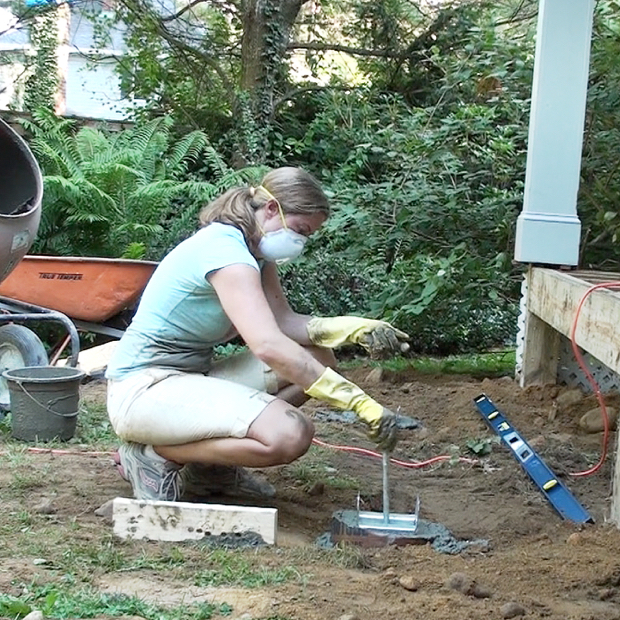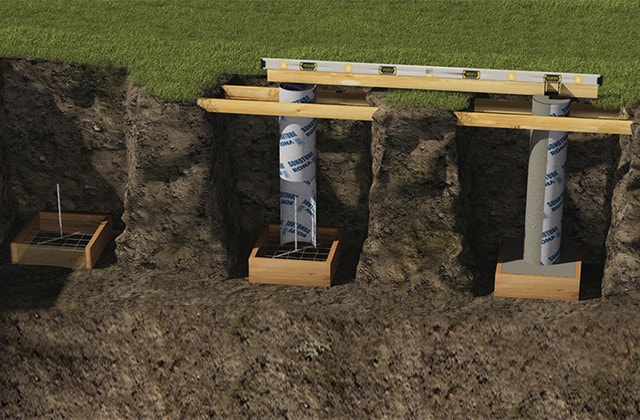Make Sure Security and Longevity With Effectively Set Up Deck Footings
Deck footings might not be the most attractive facet of deck construction, but they play an important duty in ensuring stability and longevity. Correctly set up grounds offer a strong foundation for your deck, stopping usual issues like drooping, shifting, and also collapse. Nevertheless, picking the best sort of ground and properly installing it can be a complex process. In this discussion, we will certainly discover the value of appropriate deck footings, aspects to take into consideration throughout installation, different kinds of grounds available, step-by-step installation guide, and maintenance tips for making certain long-lasting footings. So, if you intend to make sure the stability and longevity of your deck, maintain reviewing to find the vital understandings to attain a sturdy and structurally sound outdoor space.

Importance of Correct Deck Grounds
Why are correctly installed deck footings vital for the security and long life of your deck? Deck footings are the foundation on which the deck rests, moving the lots from the deck to the ground.
First of all, correctly mounted deck footings disperse the weight of the deck uniformly, avoiding any uneven settling or sinking. This is especially important in areas with unsteady dirt, as it helps to alleviate the danger of the deck changing or collapsing. Additionally, well-installed footings ensure that the deck stays level, avoiding any architectural damage that can happen when a deck ends up being uneven.
Secondly, appropriately set up grounds supply a solid anchor for the deck, stopping too much motion and persuade. This helps to keep the structural honesty of the deck, decreasing the danger of injuries or mishaps. It additionally minimizes the wear and tear on the deck, enabling it to endure the elements and regular usage for a longer time period.
Aspects to Think About for Deck Footing Installment
When installing deck footings, there are several essential factors to think about for appropriate setup. Various soil kinds have different load-bearing abilities, so it is important to perform a soil test to make certain the grounds can sustain the weight of the deck and its owners. By taking right into account these elements, you can ensure the correct installment of deck grounds and delight in a secure and resilient deck.
Kinds Of Deck Grounds to Pick From
There are several different types of deck footings offered for you to pick from. Each kind has its very own advantages and disadvantages, so it's vital to consider your particular demands and the conditions of your deck before choosing.
One common kind of deck footing is the concrete ground. This includes excavating openings in the ground and pouring concrete into them to create a strong structure. Concrete footings are long lasting and give superb stability, making them ideal for decks in locations with challenging soil problems or high wind tons.
An additional choice is the helical pier ground, which contains a steel shaft with helical plates that are screwed into the ground. These footings are fast to mount and can be utilized in numerous dirt kinds, consisting of sandy or clay soils. They are also flexible, permitting very easy leveling of the deck.
Sonotube footings are an additional preferred choice. These grounds are developed by placing a cardboard tube in an opening and loading it with concrete. Sonotube grounds are relatively very easy to install and provide sufficient stability for smaller sized decks or in areas with much less demanding dirt conditions.

When selecting the kind of deck footing, it's essential to take into consideration aspects such as dirt problems, deck size and weight, neighborhood building regulations, and individual preferences. By picking the suitable footing kind, you can make certain the stability and longevity of your deck.
Step-by-Step Guide for Installing Deck Footings

Determine the location: Start by marking the exact setting of each ground making use of risks and string (Deck Footings). Take into account any local building regulations or guidelines regarding trouble ranges
Dig the holes: Make use of an article hole digger or an auger to dig the holes for the footings. Usually, a depth of at least 36 inches is recommended for stability.
Level the openings: Make sure that all-time lows of the holes are level (Deck Footings). This can be achieved by making use of a internet level or a straight board throughout the top of the holes
Add gravel: Place a layer of crushed rock at the end of each opening to boost drainage and stop the ground from penetrating the dirt in time.
Put the footing kinds: Insert the footing develops right into the holes, ensuring they are focused and level. Usage stakes to protect them in location.
Mix and put concrete: Adhere to the instructions on the concrete mix bag to prepare the concrete. Pour the concrete into the footing kinds, filling them entirely.
Smooth the surface area: Make use of a trowel to smooth the surface area of the concrete and remove any air pockets. Permit the concrete to heal according to the supplier's guidelines.
Upkeep Tips for Durable Deck Footings
Correct upkeep is important for ensuring the longevity and stability of deck grounds. By frequently examining and keeping your deck grounds, you can stop damage and prospective safety and security hazards. One important aspect of maintenance is to regularly look for any kind of signs of damage, such as fractures or activity in the footings. If you observe any type of issues, it is crucial to resolve them promptly to stay clear of further damage.
Regular cleansing is likewise necessary for keeping deck grounds. Dirt, plants, and particles can accumulate around the additional reading footings, which can lead to moisture build-up and decay. Cleansing the footings regularly, using a brush or a stress washer, can assist avoid these issues and expand the life-span of your deck.
In addition to cleaning, it is essential to maintain the location around the footings free from any type of blockages. Avoid stacking things versus the grounds or permitting plants to grow as well near them. These obstructions can trap moisture and create the grounds to degrade in time.
Finally, routine resealing of the footings is recommended to protect them from wetness and other environmental aspects. Using a water resistant sealant can aid avoid water damage and expand the lifespan of the footings.
Conclusion
Finally, correct setup of deck grounds is essential for making sure security and long life of your deck. Aspects such as dirt useful reference kind, tons capability, and neighborhood structure codes require to be taken into consideration when choosing the ideal type of deck footings. Complying with a step-by-step overview for installation and regular upkeep will assist to ensure the grounds stay sturdy and lasting.
In this discussion, we will certainly discover the value of appropriate deck grounds, aspects to consider throughout installment, various kinds of footings available, detailed installment guide, and upkeep suggestions for making sure long-lasting grounds. Deck footings are the structure on which the deck relaxes, transferring the load from the deck to the ground.One usual type of deck footing is the concrete ground. Put the footing types: Place the ground creates right into the openings, ensuring they are focused and level.In verdict, correct installation of deck grounds is essential for making certain stability and durability of your deck.
Comments on “A Solid Structure for Your Oasis: Exploring the Relevance of Deck Footings in Outdoor Frameworks”